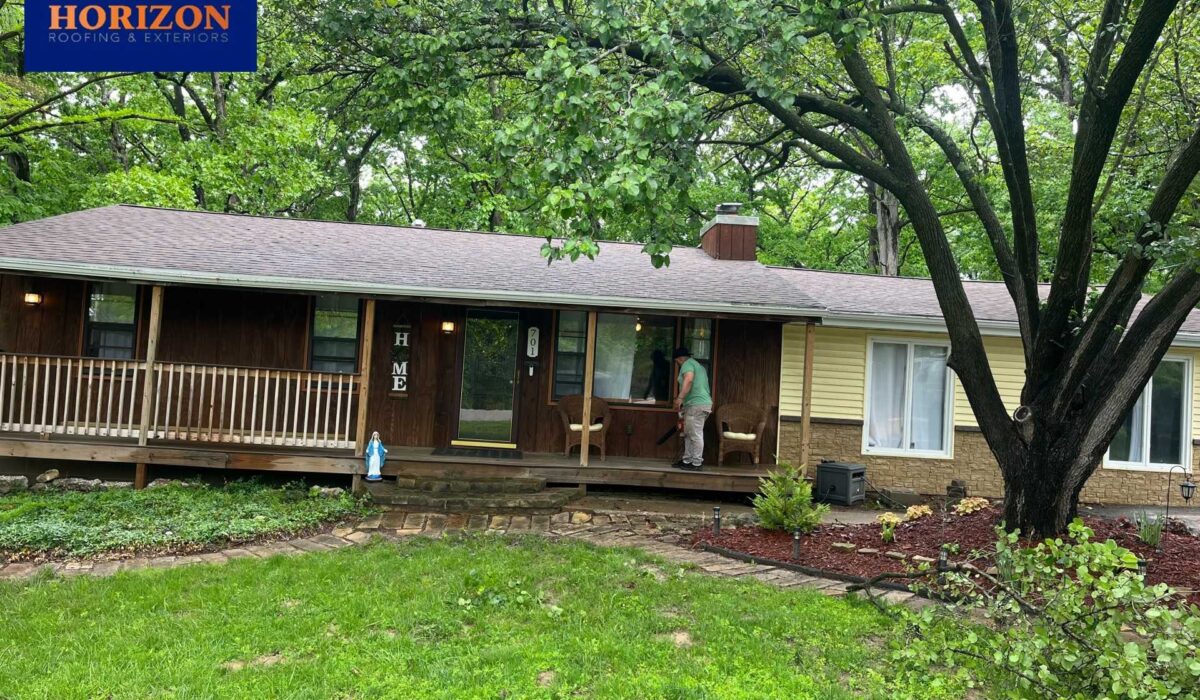- By Brian Donohue
- Roofing
- 0 Comment
Flat roofs are a popular choice for both residential and commercial properties, offering a modern look and space efficiency. However, they are more prone to water pooling and leaks compared to sloped roofs. A small leak can quickly turn into a major issue, leading to structural damage, mold growth, and expensive repairs.
We’ve helped countless homeowners and business owners with residential roof repairs in St. Louis, St. Charles, and surrounding areas. In this guide, we’ll walk you through the steps of identifying and addressing flat roof leaks, plus when to call a professional roofing contractor for help.
Step 1: Identify the Leak
Before attempting any repairs, you need to locate the leak. This is often harder on a flat roof because water doesn’t always drip directly below the damaged area. Here’s how to track it down:
1. Check for water stains on ceilings or walls inside the building.
2. Inspect the roof surface for pooling water, cracks, or punctures.
3. Examine flashing and roof seams—these are common weak points where water seeps in.
4. Look for clogged drains or gutters that could be preventing proper drainage.
If you can’t pinpoint the source, it’s best to call a professional roofing contractor to conduct a thorough inspection.
Step 2: Remove Debris and Dry the Area
Once you’ve located the leak, clear any debris (leaves, dirt, or standing water) from the affected area. Use a dry cloth or blower to ensure the surface is completely dry before moving forward with repairs. This helps adhesives and sealants bond properly.
Step 3: Apply a Roof Patch or Sealant
The type of repair depends on the severity of the damage:
For Small Cracks or Punctures: Apply a high-quality roofing sealant designed for flat roofs. Spread it evenly over the damaged area using a putty knife.
For Larger Tears or Blisters: Use a roof patch kit that includes a fabric patch, primer, and waterproof coating. Follow these steps:
- Cut a patch slightly larger than the damaged area.
- Apply primer around the leak to help adhesion.
- Place the patch and press firmly.
- Cover with a waterproof sealant and smooth out any bubbles.
Step 4: Reinforce Flashing and Seams
Most flat roof leaks occur around flashing, vents, or seams. If these areas look worn out:
Remove old caulk or sealant.
Apply new roofing cement or sealant generously.
Smooth it out for a watertight seal.
If flashing is rusted or badly damaged, it may need to be replaced.
Step 5: Prevent Future Leaks with Maintenance
Flat roofs require regular roof maintenance to prevent costly repairs down the road. Here’s what we recommend:
Inspect your roof twice a year, especially after storms.
Keep drains and gutters clear to avoid water pooling.
Apply a protective roof coating every few years to extend roof life.
Schedule professional inspections to catch issues early.
When to Call a Professional Roofing Contractor
While small cracks or punctures can sometimes be repaired with DIY solutions, major leaks, structural issues, or aging flat roofs require expert attention. At Horizon Roofing & Exteriors, we specialize in flat roof repairs and replacements and roof inspections.
If you suspect a leak or need a professional inspection, contact us today for reliable service you can trust. A well-maintained flat roof keeps your property safe and protected for years to come!
Brian Donohue
Brian Donohue is the owner of Horizon Roofing & Exteriors, the leading roofing company in St. Peters, Missouri, dedicated to delivering quality roofing solutions. With a strong background in project management, sales, and customer service, Brian has built a reputation for reliability and excellence in the roofing and construction industry.

